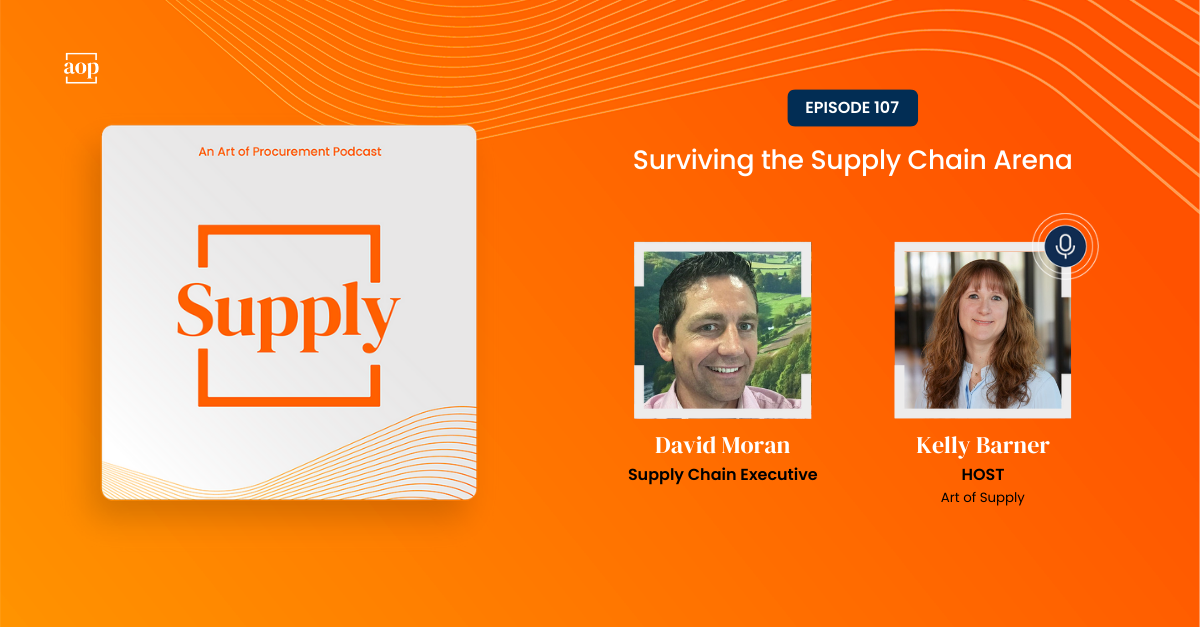
This week’s episode of Art of Supply features an interview with David Moran, an “unofficially retired” procurement and supply chain executive with over 25 years of experience working for companies like Procter & Gamble, Diageo, and Kentucky Fried Chicken.
He took a rotation through supply chain in order to build his qualifications for running a factory – and never looked back. “Why would I ever want to run a factory when you could have so much fun in procurement, working with suppliers from all over the world, negotiating deals for astronomical amounts of money and what felt like making a difference every day,” he told me.
Right from the beginning, David recognized the importance of culture and relationships, whether he was working with suppliers or internal colleagues. In both cases, it was about challenging yourself to think “beyond the deal,” challenging the status quo – albeit with empathy and respect.
From the “Easy” Days…
Reflecting back on the last couple of decades, David identified clear stages. The 2008-2009 recession is a memorable line in the sand, regardless of what function you worked in at the time. Many teams cut back in an effort to control costs, but procurement delivered anyway, justifying additional investments in headcount and resources.
And that was followed by 10 years of relatively easy sailing.
Oil prices were falling, making it possible to transport goods further globally without making them prohibitively expensive. Logistics became increasingly efficient, but – more importantly – they were also exceptionally reliable. This stability allowed teams to further stretch and optimize without taking on undue risk (or so they thought).
“We went into an amazing period of success where brands could take price and grow margin year after year after year, and procurement were the heroes.”
In fact, David’s own supply chain was running so smoothly, he went to the executive team and asked for ownership of the company’s sustainability program. He saw it as an opportunity to grow the supply chain’s influence inside of the company while improving how the operation was perceived externally.
…To the “Glory” Days
Then came 2020. I try not to relive those days if I don’t have to, so rather than asking David what it was like, I asked him about the transition from easy to hard. “When did you know it was serious?” I asked.
“I was asked the question, ‘How difficult is it to stop the supply chain?’” he remembered. “I said, it’s easy to stop the supply chain. I just have no idea how you start it back up again.”
Certainly stopping and starting labor and logistics is a worry, but David was just as focused on the flows of cash. His number one priority was making sure everyone got paid. But in those days of concern and confusion, he found himself having to answer that question repeatedly. Would there be a supply chain to go back to once businesses opened back up? No one knew for sure, and that was enough to convince him that keeping things moving was a better plan.
Sharpened Focus
Unlike 2010-2020, where resources and results were both abundant, 2020 became a high-stakes juggling act. At times, David and his team had no choice but to focus their attention so intensely that they had to stop paying attention to certain routine activities.
While none of those dropped objectives could be allowed to spiral, prioritization required the team to put them aside. Having the ability to make those decisions within the supply chain organization itself became a competitive differentiator.
“A lot of supply chains were told what they needed to do by organizations who didn’t necessarily understand supply chain and procurement or understand the consequences.” David said. “You can pretty much work out which organizations were able to plan their opening before they closed. You can do that by mapping the timeline of who opened first and who opened last.”
And yet, coming through that time changed not just the world, but an entire generation of procurement and supply chain professionals. The invaluable experience gained in those days of fighting to keep the company rolling and answering the hard questions has become a kind of brilliance that will prepare them for some future set of challenges we can’t yet envision.
To read more about the positive, lasting impact of coming through the last few years – scars and all – read this week’s Art of Supply newsletter on LinkedIn.
Links:
- David Moran on LinkedIn
- Kelly Barner on LinkedIn
- Art of Supply LinkedIn newsletter
- Art of Supply on AOP
- Subscribe to This Week in Procurement





